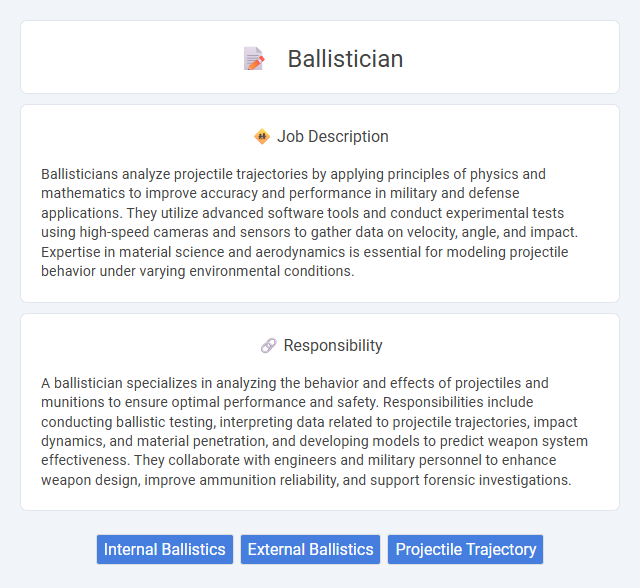
Ballisticians analyze projectile trajectories by applying principles of physics and mathematics to improve accuracy and performance in military and defense applications. They utilize advanced software tools and conduct experimental tests using high-speed cameras and sensors to gather data on velocity, angle, and impact. Expertise in material science and aerodynamics is essential for modeling projectile behavior under varying environmental conditions.
Individuals with strong analytical skills and attention to detail are likely well-suited for a career as a ballistician, as the role involves studying projectile trajectories and impact effects. Those who are comfortable working with physics, mathematics, and forensic analysis may find this profession particularly fitting. However, people who prefer less technical or investigative environments might find the job challenging or unsuitable.
Qualification
A ballistician typically holds a degree in physics, engineering, or a related field, with specialized knowledge in ballistics, dynamics, and materials science. Advanced skills in data analysis, computer simulations, and forensic investigation are essential for accurate ballistic assessments. Professional certifications and experience with firearms, ammunition, and testing protocols enhance a ballistician's expertise and employability.
Responsibility
A ballistician specializes in analyzing the behavior and effects of projectiles and munitions to ensure optimal performance and safety. Responsibilities include conducting ballistic testing, interpreting data related to projectile trajectories, impact dynamics, and material penetration, and developing models to predict weapon system effectiveness. They collaborate with engineers and military personnel to enhance weapon design, improve ammunition reliability, and support forensic investigations.
Benefit
Working as a ballistician likely provides a strong benefit in developing advanced analytical and problem-solving skills, valuable across defense, law enforcement, and forensic fields. There is a high probability of gaining expertise in physics and material science, enhancing career opportunities in specialized sectors. Benefits may also include involvement in cutting-edge research and technology development, contributing to public safety and national security.
Challenge
A job as a ballistician likely involves complex calculations and predictions about projectile trajectories, presenting significant analytical challenges. The role probably requires constant problem-solving under uncertain conditions, demanding precision and adaptability. Handling advanced modeling tools might also be integral, increasing the technical difficulty of the position.
Career Advancement
Ballisticians with advanced degrees and specialized certifications often secure leadership roles in defense research, aerospace engineering, and forensic analysis. Gaining expertise in computer modeling, data analysis, and materials science significantly boosts career progression opportunities. Continuous professional development and project management experience are critical for transitioning into senior technical or managerial positions.
Key Terms
Internal Ballistics
A ballistician specializing in internal ballistics studies the behavior of propellants and projectiles inside firearms from ignition to muzzle exit. This role involves analyzing pressure curves, combustion processes, and barrel dynamics to optimize weapon performance and ensure safety standards. Expertise in thermodynamics, fluid dynamics, and material science is essential for accurate testing and development of ammunition systems.
External Ballistics
External ballistics involves analyzing the flight trajectory of projectiles after they leave the barrel, requiring deep knowledge of aerodynamics, atmospheric conditions, and projectile dynamics. Ballisticians specializing in this field use advanced mathematical models and simulation software to predict bullet drop, drift, and velocity decay. Expertise in data interpretation and precision measurement tools ensures accurate trajectory predictions critical for military, aerospace, and defense applications.
Projectile Trajectory
A ballistician specializes in the analysis and prediction of projectile trajectory by applying advanced physics and mathematics principles. They utilize computational models to calculate flight paths, accounting for variables such as velocity, air resistance, gravity, and wind conditions. Precision in trajectory analysis is crucial for applications in defense, aerospace, and forensic investigations.
 kuljobs.com
kuljobs.com